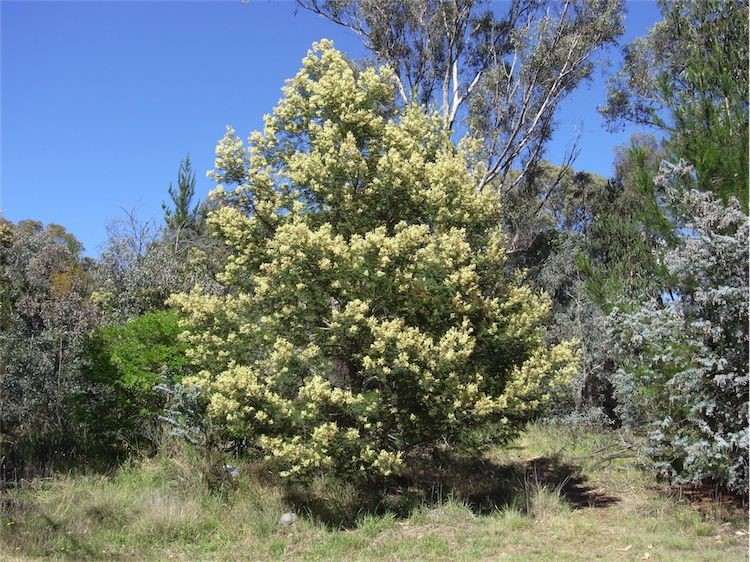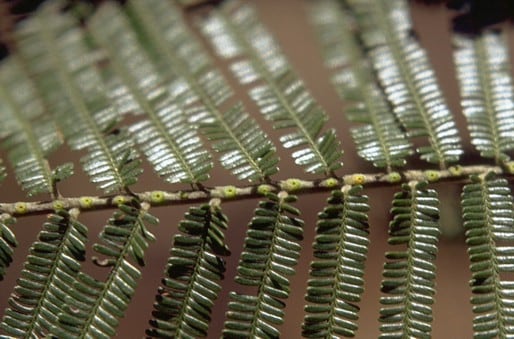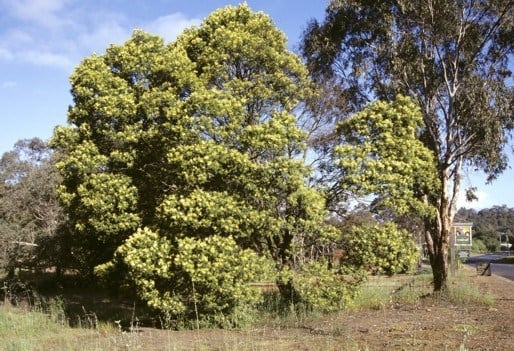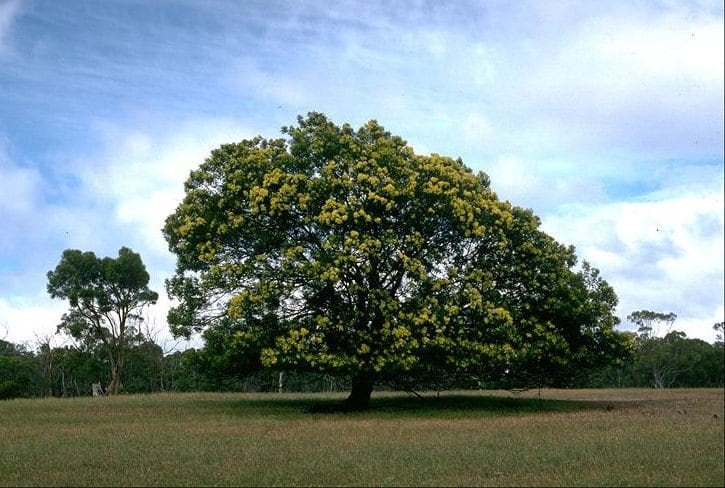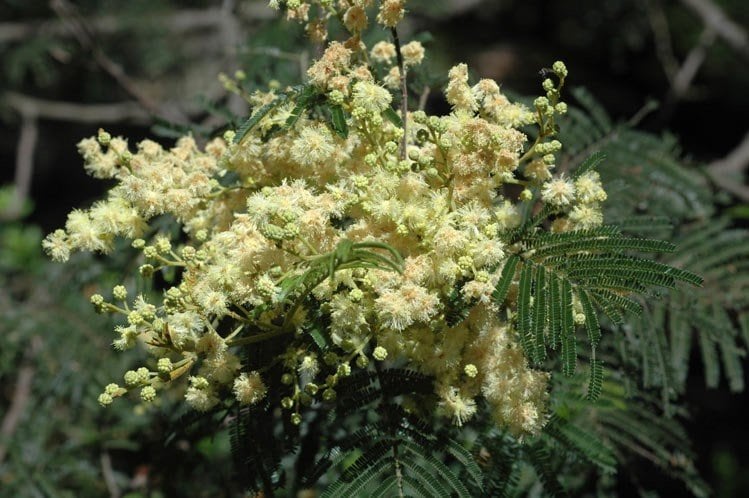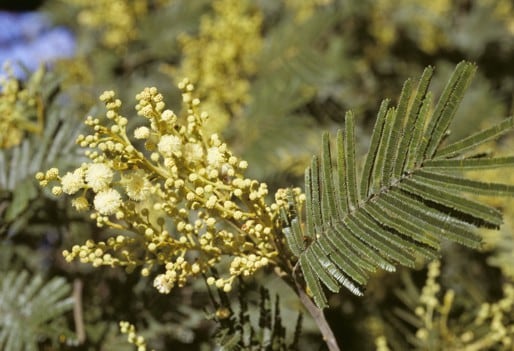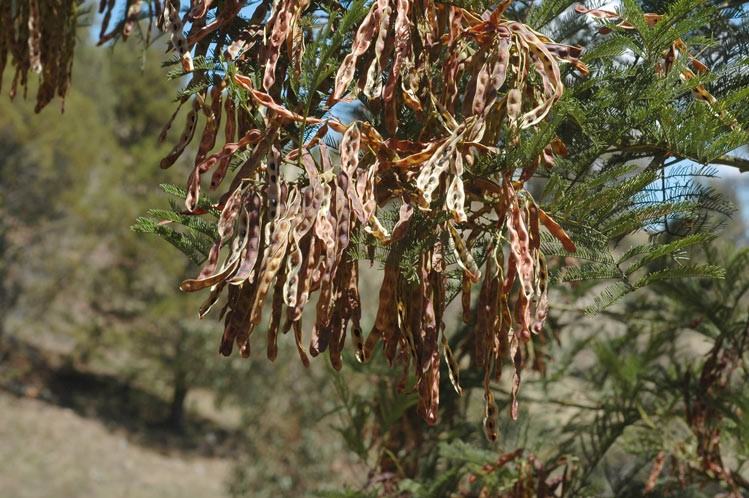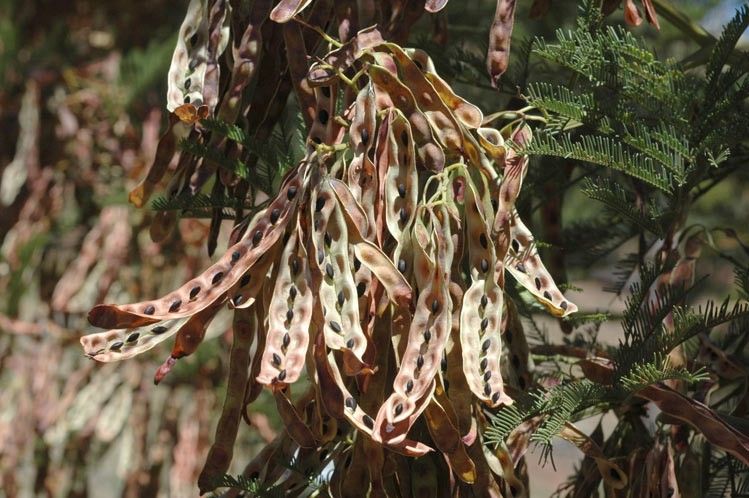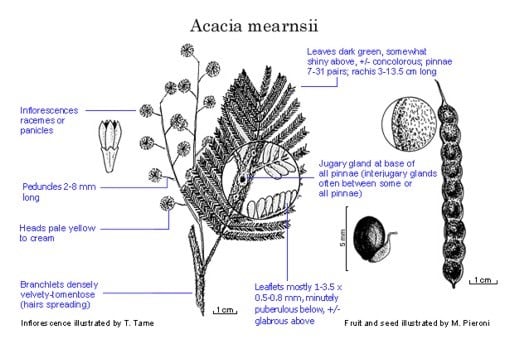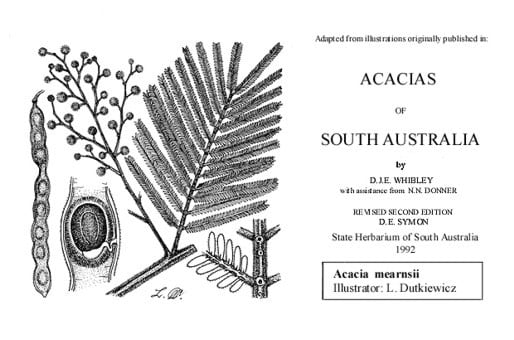Acacia mearnsii De Wild.
WATTLE
Acacias of Australia
Common Name
Black Wattle
Family
Fabaceae
Distribution
Occurs in N.S.W. S from Central Mangrove along the coast and tablelands (including the A.C.T.), widespread in Vic. and Tas., also in S.A. S of Naracoorte. There are naturalised records for N.S.W., the Mt Lofty Ra., S.A., and south-western W.A.
Description
Spreading shrub or mostly erect tree to 10 (–16) m high. Bark of trunk smooth, corrugated at base when old, black or grey. Branchlets angular with short ridges, non-glaucous, densely velvety-tomentose. Young foliage-tips yellow or greenish yellow, velvety-pubescent. Leaves subcoriaceous, dark green and glossy above, concolorous or slightly paler beneath; petiole above pulvinus 0.5–2.5 cm long, shortly ridged, with an orbicular grey-tomentellose gland at base of or to 8 mm below lowest pair of pinnae; rachis mostly 3–13.5 cm long, with a similar gland near base of each pair of pinnae, usually with 1 or 2 often confluent interjugary glands between some or all pairs of pinnae; pinnae 7–31 pairs, 1.5–6 cm long; pinnules (16–) 25–78 pairs, cultrate to narrowly oblong or slightly spathulate, 1–3.5 (–4) mm long, 0.5–0.8 mm wide, with inconspicuous midnerve, ±glabrous above, densely grey-puberulous below, broadly rounded and auriculate at base, broadly rounded, truncate or obtuse at apex. Inflorescences in axillary racemes, or terminal or axillary false panicles; peduncles 2–8 mm long, white- to golden-hairy. Heads 20–40-flowered, pale yellow or cream-coloured. Pods barely constricted between seeds to ±submoniliform or irregularly more deeply indented, straight to curved, 3–15 cm long, 4.5–8 mm wide, coriaceous, black, red-brown or dark brown, slightly scabrous, grey-puberulous.
Phenology
Flowers mainly Oct.–Dec.; fruits Oct.–Feb.
Habitat
Grows in open forest, woodland or tussock grassland, in gullies or on hillsides, in sandy or gravelly clay soils.
Specimens
W.A.: northern outskirts of Nannup, G.J.Keighery 9469 (PERTH n.v.). S.A.: Mons Gambir [Mount Gambier], F.Mueller (MEL). N.S.W.: near Burrewarra Pt, S of Bateman’s Bay, L.A.Craven 631 (B, CANB, K, MEL, UC, US); 3.2 km S of Yerrinbool, M.D.Tindale s.n. (NSW52614). A.C.T.: lower NE slopes of Black Mtn, Canberra, R.Pullen 10364 (CANB, NSW). Vic.: Grampians, ±4 km N of Zumsteins, S.T.W.Parfett 78 (MEL, NSW, PERTH); E of Lakes Entrance, A.N.Rodd 4292 (HO, MEL, NSW). Tas.: Clark Is., Baudinet (MEL); 6 miles [9.7 km] from St Helen’s, 7 Dec. 1965, M.E.Phillips (CANB, NSW).
Notes
Acacia mearnsii is the principal source of tanning bark in Africa where it is cultivated in plantations. The tan bark industry based on A. mearnsii, in Africa and elsewhere, is summarised by A.E.Orchard & A.J.G.Wilson, Utilisation of the Australian Flora, in Fl. Australia 2nd edn 1: 437–466 (1999). This species was described by E.De Wildman, who believed that it was native to East Africa. The excluded syntype, from the vicinity of Nairobi, British East Africa, E.A.Mearns 249 (BR) is Acacia dealbata. Further information on the biological and ecological features, and the utilisation potential, of this species is given in B.R.Maslin and M.W.McDonald, AcaciaSearch: Evaluation of Acacia as a woody crop option for southern Australia, RIRDC Publication No. 03/017, 118–126 (2004).
Allied to A. parramattensis, A. loroloba and A. constablei.
FOA Reference
Data derived from Flora of Australia Volumes 11A (2001), 11B (2001) and 12 (1998), products of ABRS, ©Commonwealth of Australia
Author
Minor edits by B.R.Maslin & J.Reid
M.D.Tindale, P.G.Kodela
This identification key and fact sheets are available as a mobile application:
URL: https://apps.lucidcentral.org/wattle/
© Copyright 2018. All rights reserved.
